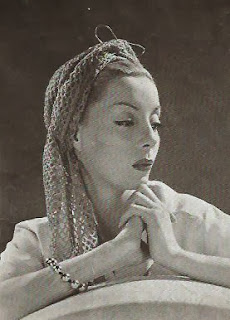On Sunday I bought "Vogue's 15th Knitting Book" at a local vintage market for $2.00. A quick flick through the book told me it was from the 1930s so I quickly snapped it up. It was only when I got home that I realised that most of the pages in the book were well and truly stuck together.
Time to try steaming them apart. I know the theory, but I'd never actually tried it. I boiled a saucepan of water and gave it a go.
Separating the cover from the first page was the most difficult and took about half an hour. There was a fair bit of damage to the inside cover and some tearing. I'm not sure what made this book stick together, but I suspect dampness as there was no sign of food or drink.
As more pages came free I saw that the models had 1940s hair dos, so I though maybe the book was very early 40s. I just love this ad:
Those braided evening coats are well left behind in 1939 if you ask me.
The original owner of the book had filed lots of newspaper clippings on various topics inside the pages of the knitting book. The stuck together pages formed little envelopes which, on being steamed open, released their little treasures. I had quite a collection of these by the time I finished steaming the book. Some were from the 50s, but some bore the partial date: "193..." Aha, I thought, 1939! It all makes sense. What was special about these articles? There were two articles from 1939 about a bread price cutting war and the union campaign involved, a few celebrity photos from the 40s and 50s, a society wedding snap and two clippings from a religious publication, one showing a nativity scene and the other the Saint Ann's Mission Church. I can't see why anyone would want to keep any of them. I guess it is just a cross section of a woman's interests, and gives us a glimpse of her personality.
During the many hours I have spent trawling Pinterest and putting together my fashion decades boards I have noticed that the very end of a decade heralds the following decade. Likewise, the early years of a decade echo the second half of the previous decade. Here, in Vogue in 1939, we had distinctively 1930s patterns, with the new wartime hairdos, the "Victory Roll", and echoes of the fashions to come in the early 40s.


As I stood there for an hour bringing this book back to life, strange thoughts filled my head. What were these newspaper articles and why had they been kept? 1939, the war. Was there something special about these articles, and had they been deliberately sealed up and hidden inside this book? Spies!! I looked for a secret code. My over active imagination ran away with me. The other thought I had was, what a lot of steam, and what a shame I hadn't put the Christmas pudding into the pot before I began. The ingredients were still staring at me from the bench top making me feel guilty.
My 1939 theory was confirmed when I found this ad:
Note at the very top underneath the heading "Darnley's London 1912 - 1939" .
Here are some fabulous turbans:
This gorgeous little evening jacket features knitted smocking.
When I finished I came to the conclusion that this book takes the award for best photos inside the most uninteresting cover.
That, and the fact that the pages were stuck together and difficult to see explains why I was able to purchase the book so cheaply. I have not been able to find another copy of this book on the internet. The oldest editions of Vogue knitting books I could find came from the early 50s.
The book is in fairly good condition now, except for a little invisible tape repairing the tears on the inside of the cover. I have committed the collector's sin of repairing the spine of the cover with invisible tape (on the inside, of course). I have too much OCD to tolerate the tatty when I can easily have the neat. It looks beautiful now. Thank goodness it was stuck together and full of secrets wonderful and ordinary, just waiting for me to come along and discover it.

















